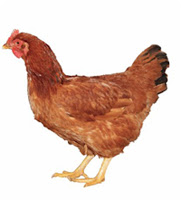Commercial (Domestic) Turkey
The domestic turkey (Meleagris gallopavo) is a large fowl, one of the two species in the genus Meleagris and the same as the wild turkey. Although turkey domestication was thought to have occurred in central Mesoamerica at least 2,000 years ago, recent research suggests a possible second domestication event in the Southwestern United States between 200 B.C and 500 A.D. However, all of the main domestic turkey varieties today descend from the turkey raised in central Mexico that was subsequently imported into Europe by the Spanish in the 16th century.
Turkey can be reared in commercial quantity mainly for meat production and turkey breeding (hatchery). The major breeds of turkey are Large White, Broad Breasted Bronze and Small White. Large White and Broad Breasted Bronze are large birds which can reach 11 kg in 24 weeks. Small White can only reach 6.5 kg in 16 weeks.
Turkey can be reared in commercial quantity mainly for meat production and turkey breeding (hatchery). The major breeds of turkey are Large White, Broad Breasted Bronze and Small White. Large White and Broad Breasted Bronze are large birds which can reach 11 kg in 24 weeks. Small White can only reach 6.5 kg in 16 weeks.
 |
| Large White Turkey |
The details of breeds of turkey are as follow:
1.) The Broad Breasted White: This is the commercial turkey of choice for large scale industrial turkey farms and most consumed variety of the bird.
2.) The Broad Breasted Bronze: This is another commercially developed strain of table bird.
3.) The Standard Bronze: This looks much like the Broad Breasted Bronze, except that it is single breasted, and can naturally breed.
4.) The Bourbon Red Turkey: This is a smaller, non-commercial breed with dark reddish feathers with white markings.
5.) Slate or Blue Slate turkey: This is very rare breed with gray-blue feathers.
6.) The Black, Spanish Black or Norfolk Black has very dark plumage with a green sheen.
7.) The Narragansett Turkey is a popular heritage breed named after Narraganset Bay in New England.
8.) The Chocolate is a rarer heritage breed with markings similar to a Black Spanish, but light brown instead of black in color. Common in the Southern U.S and France before the Civil War.
9.) The Beltsville Small White is a small heritage breed, whose development started in 1934. The breed was introduced in 1941. Although slightly bigger and broader than the Midget White, both are often mislabeled.
10.) The Midget White is a smaller heritage breed.
2.) The Broad Breasted Bronze: This is another commercially developed strain of table bird.
3.) The Standard Bronze: This looks much like the Broad Breasted Bronze, except that it is single breasted, and can naturally breed.
4.) The Bourbon Red Turkey: This is a smaller, non-commercial breed with dark reddish feathers with white markings.
5.) Slate or Blue Slate turkey: This is very rare breed with gray-blue feathers.
6.) The Black, Spanish Black or Norfolk Black has very dark plumage with a green sheen.
7.) The Narragansett Turkey is a popular heritage breed named after Narraganset Bay in New England.
8.) The Chocolate is a rarer heritage breed with markings similar to a Black Spanish, but light brown instead of black in color. Common in the Southern U.S and France before the Civil War.
9.) The Beltsville Small White is a small heritage breed, whose development started in 1934. The breed was introduced in 1941. Although slightly bigger and broader than the Midget White, both are often mislabeled.
10.) The Midget White is a smaller heritage breed.
You may also like to read more about:
* How to brood day old turkeys (poults)
* Feed and space requirements for turkey
* Medication and vaccination schedule for turkeys
* How to brood day old turkeys (poults)
* Feed and space requirements for turkey
* Medication and vaccination schedule for turkeys
For quick updates and comments, follow us on our social media connects; FacebookPage, TwitterHandle and Instagram. You can also subscribe and watch videos on our YouTube channel. At Artib Farm, we materialize your satisfaction!
References
1. Domestic turkey - http://en.wikipedia.com, retrieved on May 22nd, 2019.
2. How to brood poults, Turkey feed and space requirements - https://artibfarm.blogspot.com, retrieved on May 22nd, 2019.
3. Turkey brooding and management - https://extension.umaine.edu, retrieved on 5th of May, 2019.
1. Domestic turkey - http://en.wikipedia.com, retrieved on May 22nd, 2019.
2. How to brood poults, Turkey feed and space requirements - https://artibfarm.blogspot.com, retrieved on May 22nd, 2019.
3. Turkey brooding and management - https://extension.umaine.edu, retrieved on 5th of May, 2019.



Comments
Post a Comment